Masterpiece Story: Monet’s Garden at Giverny
Claude Monet loved gardening almost as much as he loved painting. When he finally settled in Giverny, he created a natural masterpiece which acted as...
Catriona Miller 23 November 2025
September created by Limbourg brothers is a masterpiece of medieval art and autumn art that captures the experience of seasonal life in 15th-century Europe.

Limbourg brothers, September in Très Riches Heures du Duc de Berry, 1412–1416, Musée Condé, Chantilly, France.
The early 15th century was an interesting transitional period overlapping the late Gothic and early Renaissance eras. It was devastated by the reoccurring waves of epidemics, especially the infamous plagues in 1400, 1438, 1456, 1464, and 1481–1486. However, it was equally marked by the long-term trends of rising centralized governments, growing royal courts, and expanding art patronage.
The French royal court was no exception to this trend as King Charles V solidified his position and riches. His brother, Jean de Valois, Duke of Berry (1340–1416) benefited and amassed the largest private fortune in the kingdom, which he then used to fuel his passion for commissioning and collecting art. His personal library contained over 300 manuscripts at a time when even the richest nobility only had one book (normally a family bible) due to books’ extreme costliness. September, from the manuscript Très Riches Heures du Duc de Berry, is therefore a rare surviving masterpiece from the Duke’s collection and represents the beautiful season of autumn.
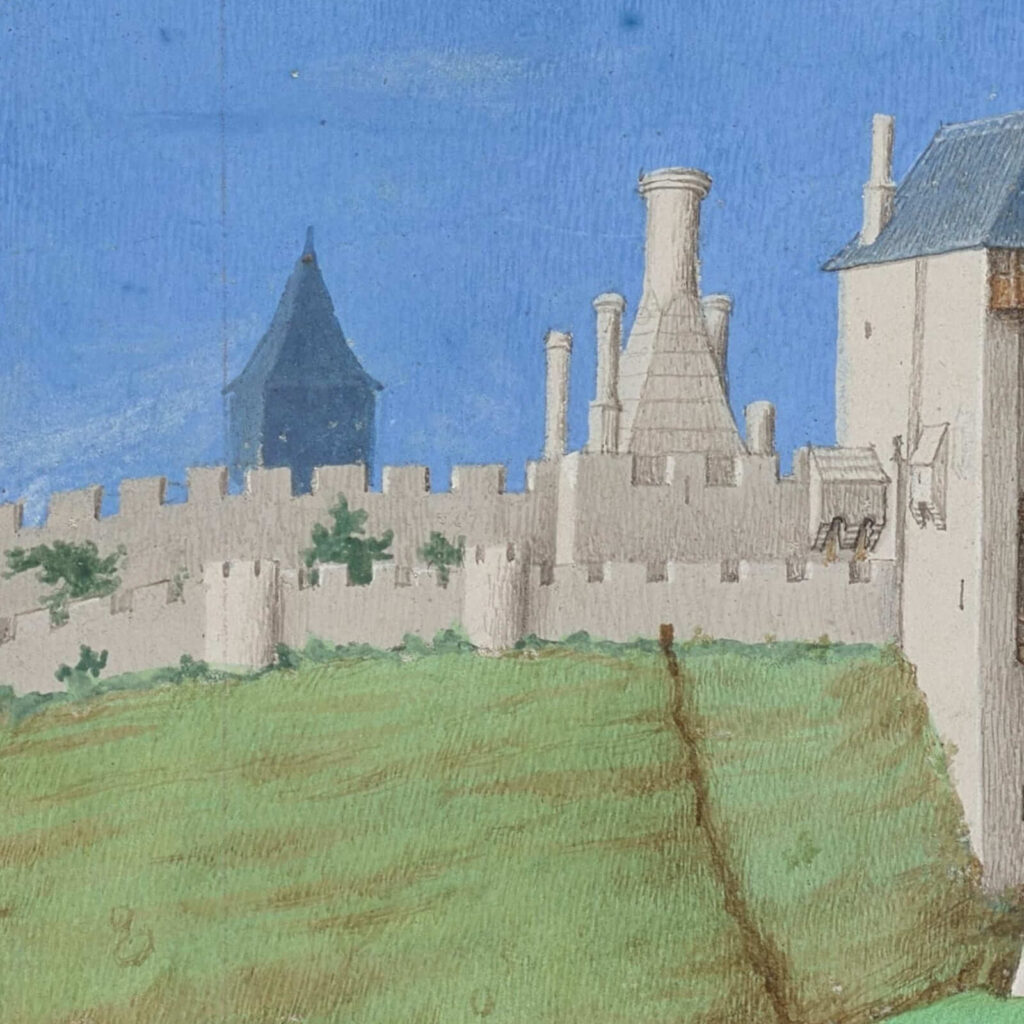
Limbourg brothers, September in Très Riches Heures du Duc de Berry, 1412–1416, Musée Condé, Chantilly, France. Detail.
The month of September contains the September Equinox, which marks the end of astronomical summer and the beginning of astronomical autumn in the Northern Hemisphere. Depending on the alignment of the calendar year versus the solar year, the equinox will occur from the 21st to the 24th of September. Therefore, September is strongly associated with the new season of autumn. It is the month of falling leaves and grape harvesting. Consequently, September from Très Riches Heures du Duc de Berry celebrates autumn with its grape-harvesting scene.
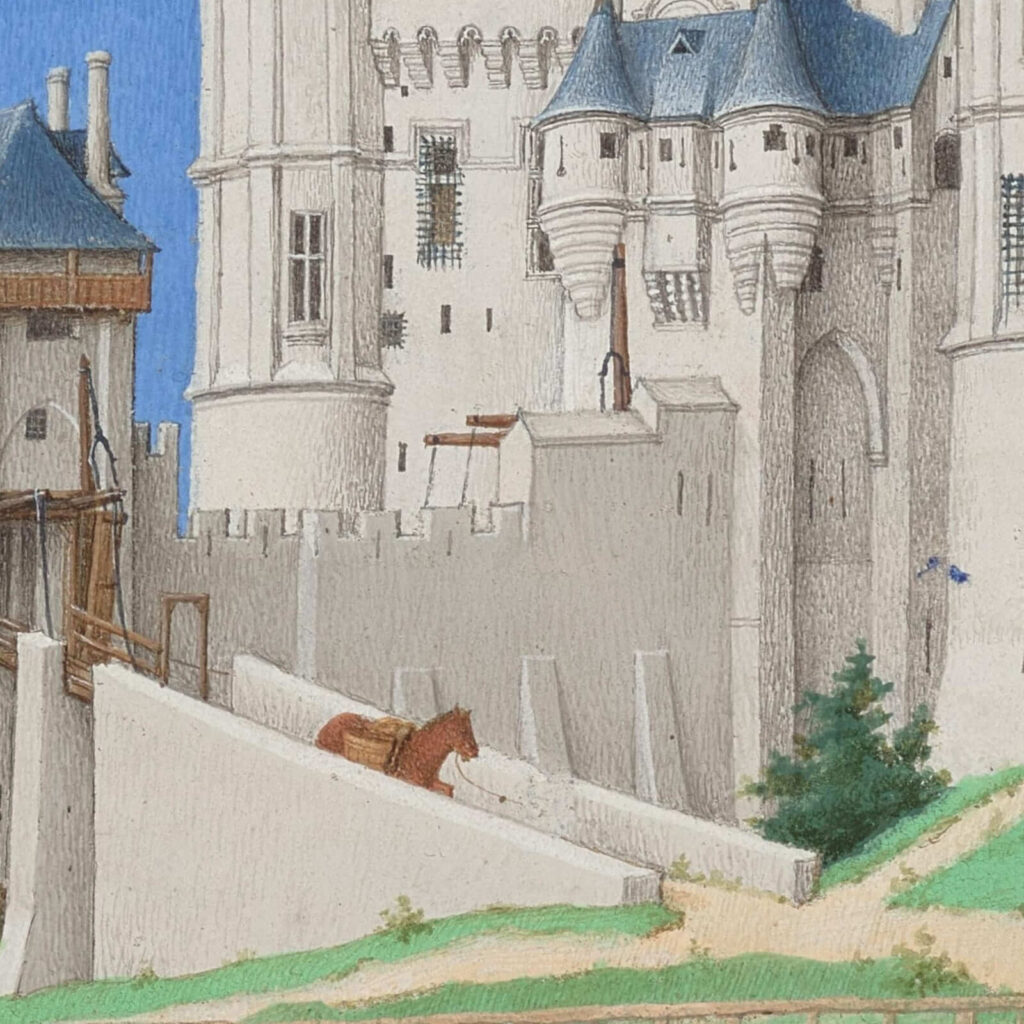
Limbourg brothers, September in Très Riches Heures du Duc de Berry, 1412–1416, Musée Condé, Chantilly, France. Detail.
September is one of 12 large images creating an illustrated calendar at the beginning of Très Riches Heures du Duc de Berry. The calendar is the first of 12 sections, or chapters, with the following 11 sections devoted to prayers and other religious subjects. September is made of ink on vellum (animal parchment) and measures 14 x 22 cm. (5 1/2 x 8 1/2 in.). It is Folio 9 verso out of 206 folios, which would be similarly compared as page 18 out of 412 pages. In the book’s calendar, when viewed, the left page is a full-page illustration, and the right page has the days’ numbers and holy feast days.

Limbourg brothers, Interior of Très Riches Heures du Duc de Berry, 1412–1416, Musée Condé, Chantilly, France.
The image of September is a beautiful medieval landscape with the vibrant luminosity and rich jewel-like colors reminiscent of contemporary stained glass windows. In the background, it features a white, tall, majestic castle with many towers, turrets, and crenellations. In the mid-ground, a horse exits the castle while a woman, a donkey, and two oxen walk towards the castle. In the foreground, eight peasants work the grape vines with the help of two donkeys and two oxen.
Many modern viewers will be surprised to discover another fact about the Limbourg brothers’ piece of art. The beautifully fanciful castle is not a fictitious, idealized castle but is, in fact, the pictorial representation of a historically accurate building. Its purpose as a royal residence is declared through the fleur-de-lis sculptures surmounting its walls. This Disney-like castle is surprisingly the Château du Louvre, the Medieval ancestor to the Renaissance Palais du Louvre, which was later converted to the Musée du Louvre in 1793.
Therefore, this agricultural scene, a land filled with grapes, peasants, and beasts of burden, is in fact the heart of medieval Paris, France! Early 15th-century Parisians would probably never imagine the scale and density of urban 21st-century Paris. The incredible difference is 600 years of urban development and expansion.
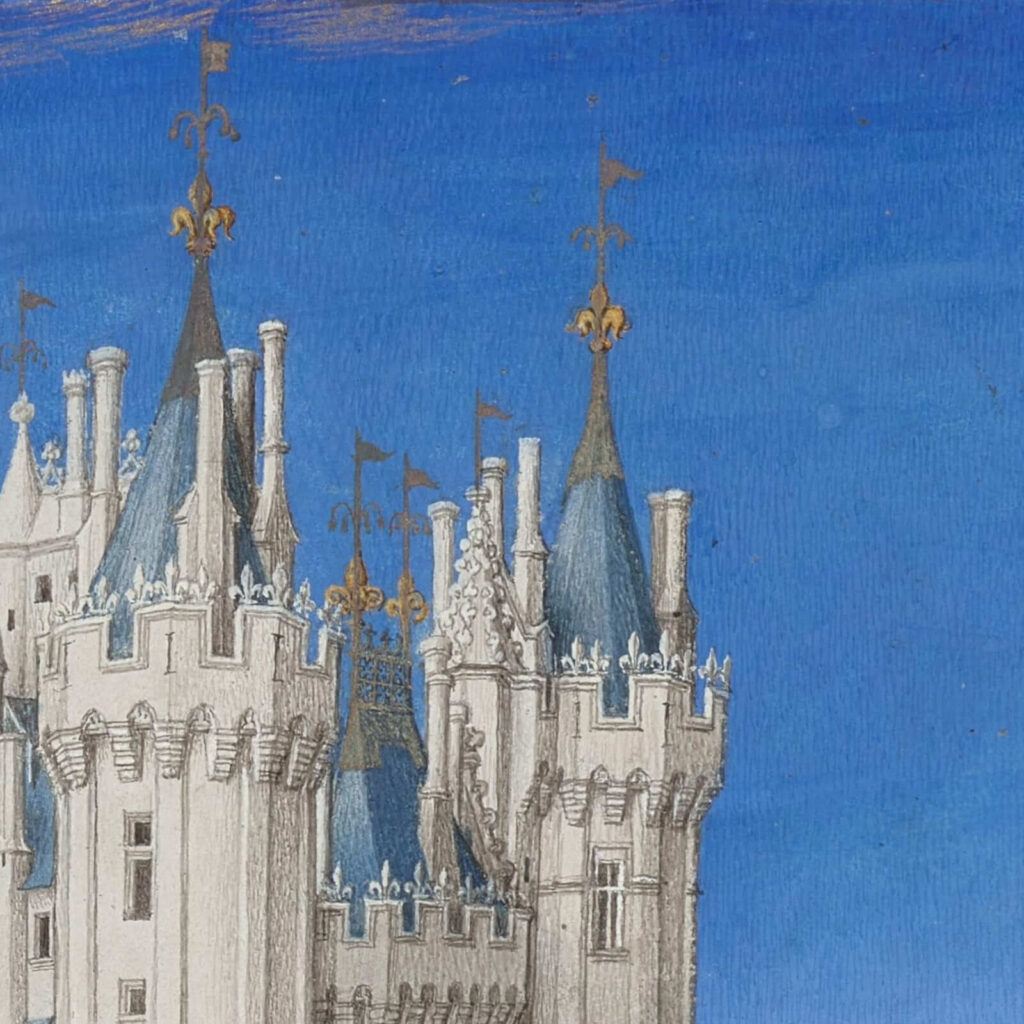
Limbourg brothers, September in Très Riches Heures du Duc de Berry, 1412–1416, Musée Condé, Chantilly, France. Detail.
The foreground is populated by eight fieldworkers and four animals. Each worker is individualized and distinctive, like characters in a well-developed novel. They are not generic archetypes but representations of different grassroots lives. In the bottom left corner is the industrious woman with a child. Her white apron dramatically drapes over her rotund belly, emphasizing her fertile condition. Her arms are raised to her head as if she is adjusting her purple headpiece. Her face looks calm, as if implying that she is at ease with her dual situation as an expectant mother and as a working woman.
Modern doctors promote exercise to mothers-to-be to prevent muscle atrophy and promote health to both mother and child over the nine month term. Therefore, it could be assumed that, as a field worker, she is in excellent health because of the stamina and strength required to fulfill the job’s demands.
To the right of the expectant mother is a man standing and eating a bunch of grapes. Is he authorized to snack on the noble’s grapes? If there is a penalty or punishment, his relaxed attitude does not portray any fears.

Limbourg brothers, September in Très Riches Heures du Duc de Berry, 1412–1416, Musée Condé, Chantilly, France. Detail.
Let’s discover something else about this beautiful piece of art created by the Limbourg brothers. To the right of the grape-eater are two peasants hunched over actively collecting grapes. This is a backbreaking position that tests the endurance and strength of any worker. However, there is a social irony between peasants and the nobility.
While the peasants had the simplest food and had the most hours of physical exertion, archaeologists and forensic scientists have discovered that most medieval peasants were in better health than their noble overlords. Their bland food of wheat, beans, and vegetables were packed full of vitamins and nutrients without the sugars and fats easily accessible to the nobility. Their frequent exertions of work were the equivalent of exercise and kept their bodies strong and maintained. There was a very low chance of muscle atrophy for a peasant with a full life of manual duties and responsibilities. A noble lady could lounge about and have a very leisurely existence. A peasant woman did not have that choice.

Limbourg brothers, September in Très Riches Heures du Duc de Berry, 1412–1416, Musée Condé, Chantilly, France. Detail.
Further to the right are two donkeys standing in the fields. They are saddled with baskets on either side filled with grapes. The field workers have been clearly collecting and then placing the grapes into the side baskets. Once the baskets are filled, it is assumed that someone will lead the donkeys to a grape press to deposit the grapes, which will ultimately be converted into wine. How delicious!
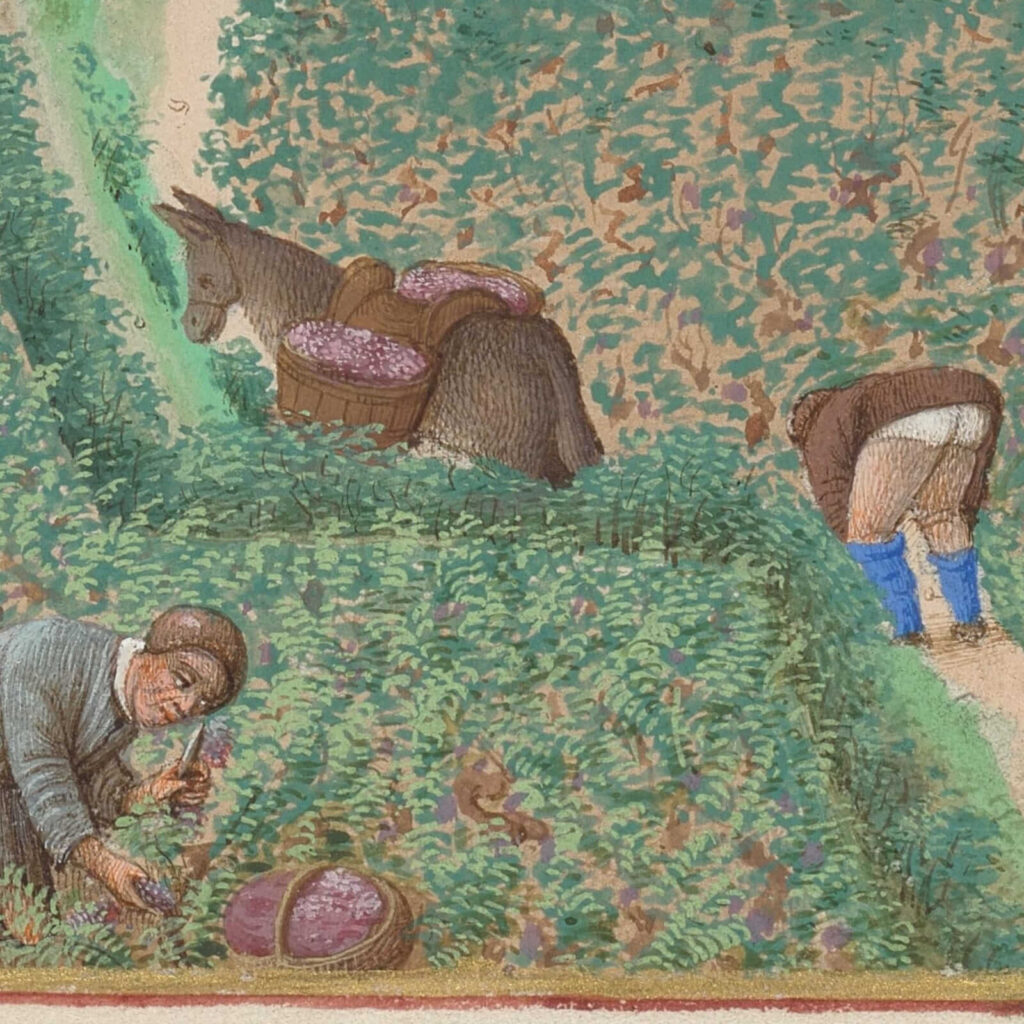
Limbourg brothers, September in Très Riches Heures du Duc de Berry, 1412–1416, Musée Condé, Chantilly, France. Detail.
More to the right is a peasant leaning in the field with his bottom facing the viewer. The Limbourg Brothers are expressing in their art a sense of humor by showing this peasant’s butt and white undergarments. After more than 600 years separating the Limbourg Brothers and modern viewers, butt humor still exists.
To the far right is a man leading two oxen off the page. They pull a cart with two large barrels filled with grapes. Like the two donkeys further to the left in the field, the oxen and man are probably heading to a grape press or some other collection point.
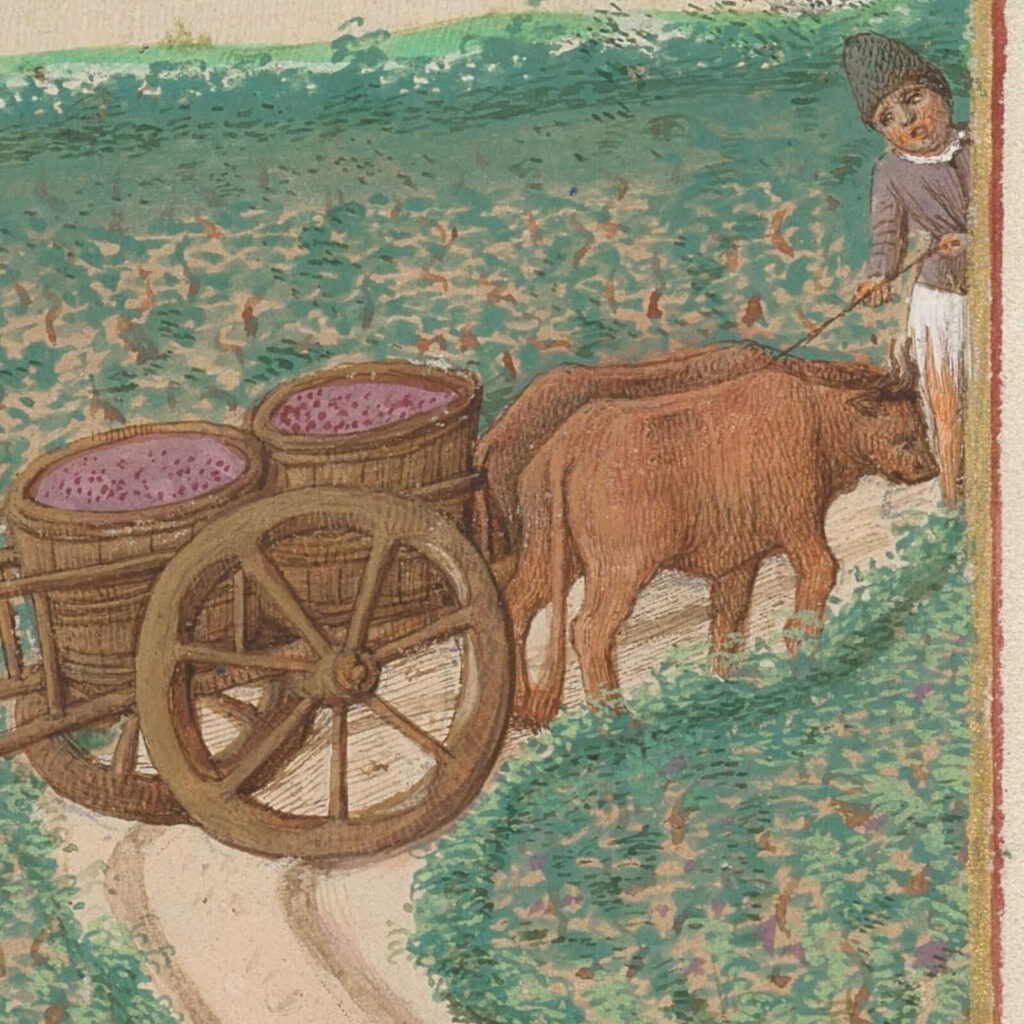
Limbourg brothers, September in Très Riches Heures du Duc de Berry, 1412–1416, Musée Condé, Chantilly, France. Detail.
Above the landscape scene is a semi-circle area filled with yellow stars and unusual figures. In the centre of the crescent area is the representation of the mythical sun chariot. Helios, the ancient Greek sun god, drove a chariot that pulled the sun across the sky.

Limbourg brothers, September in Très Riches Heures du Duc de Berry, 1412–1416, Musée Condé, Chantilly, France. Detail.
Surrounding Helios is another band of stars. This band represents the zodiac. On the left is the maiden representing Virgo, the zodiac sign for anyone born from August 23 to September 22.
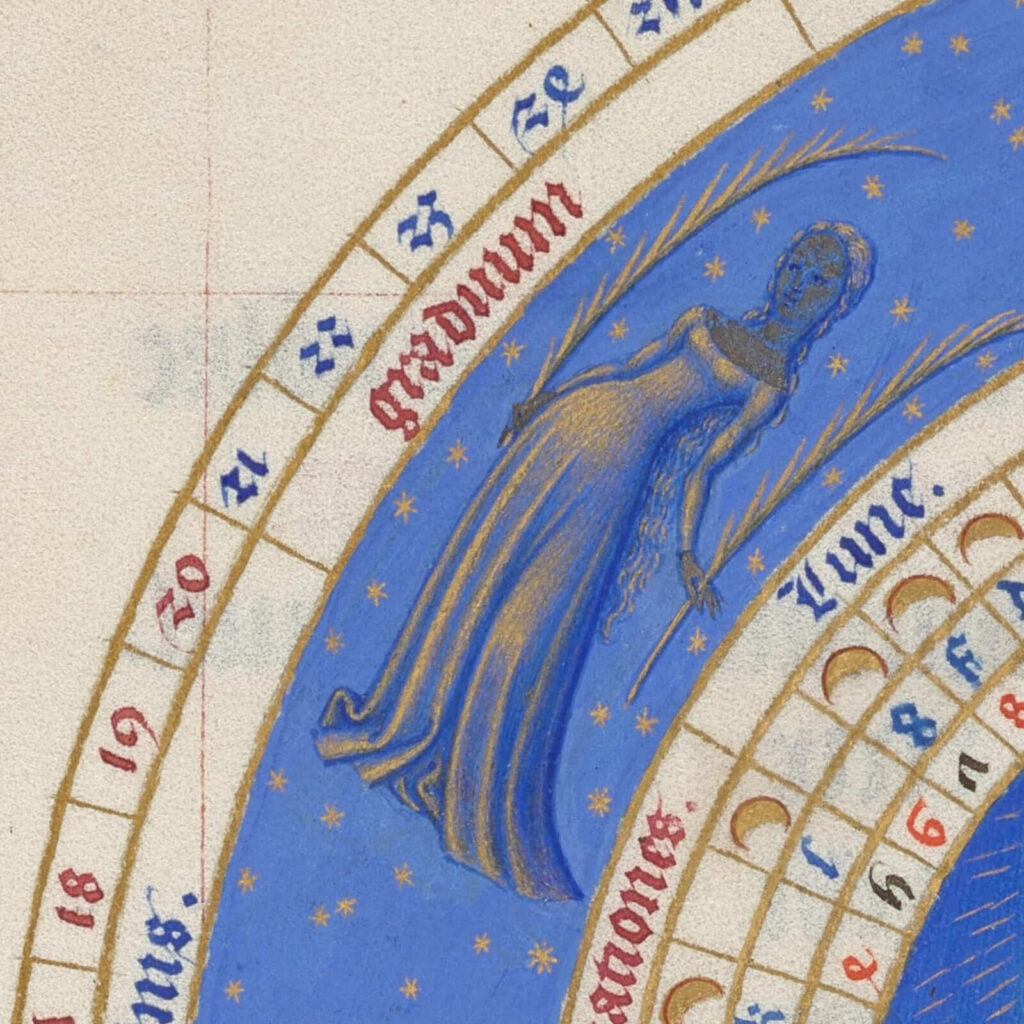
Limbourg brothers, September in Très Riches Heures du Duc de Berry, 1412–1416, Musée Condé, Chantilly, France. Detail.
On the right is the scale representing Libra, the zodiac sign for anyone born from September 23 to October 22. Therefore, the Limbourg Brothers reference in their art ancient Greek mythologies that normally would not align with Christian dogma. However, they’re surprisingly featured within the pages of a Christian book.
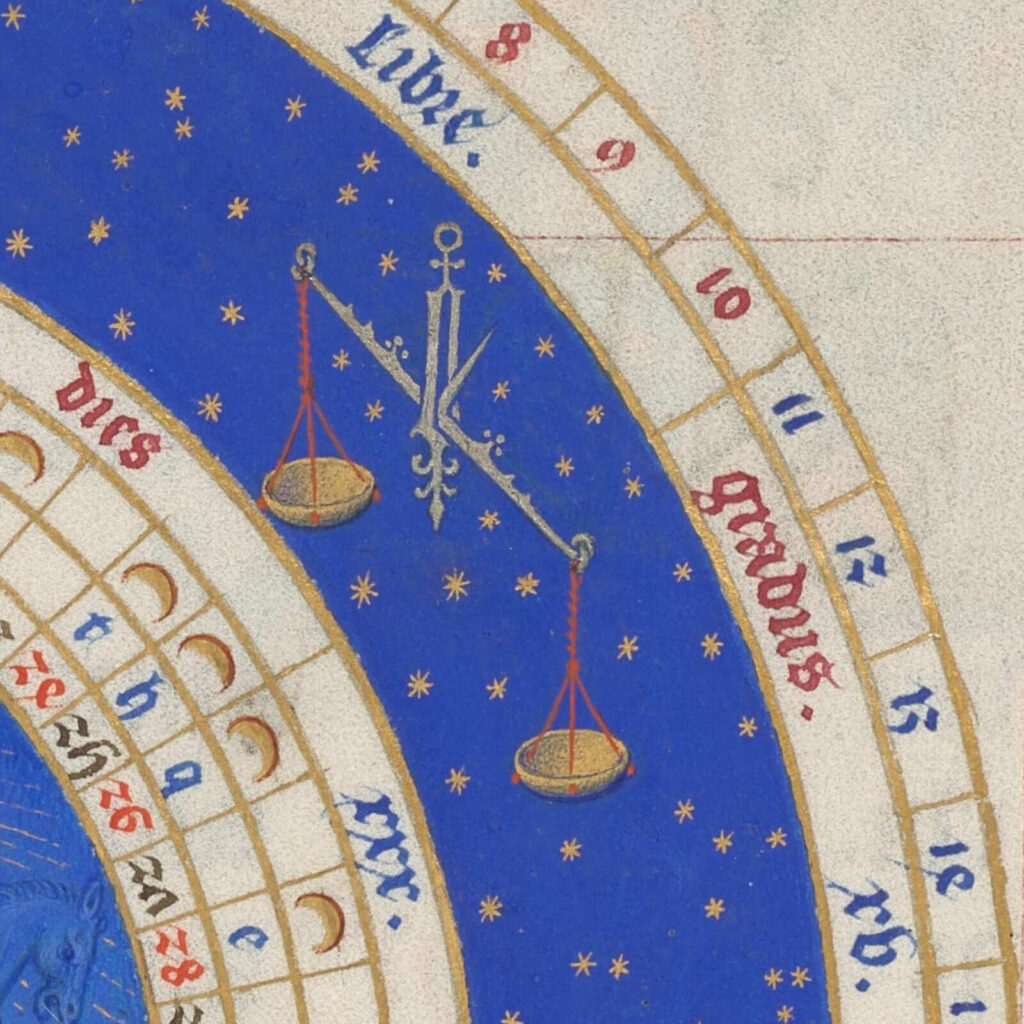
Limbourg brothers, September in Très Riches Heures du Duc de Berry, 1412–1416, Musée Condé, Chantilly, France. Detail.
September is one of the most famous images from one of the most famous illuminated manuscripts in Western art history. It has become iconic among medieval art enthusiasts because of its evocation of 15th-century Paris. It captures a lost time when grape fields grew alongside the Louvre and Paris was much less urbanized. September also captures the strong social order and hierarchy present in the 15th century through the king’s castle dominating the scene above the working peasantry. The image blends political and religious power and creates an interesting dynamic between secular and divine rule. The Limbourg brothers’ work could be disregarded as simply a scene of autumn, however, it is much more complex and more like a time capsule of seasonal life.
September is a masterpiece of medieval and autumn art. The Limbourg brothers would be happy to know that their art is remembered more than 600 years after their death in 1416. Their artistic legacy lives on, and while not much of their world remains today, their September remains the same beautiful autumn image to continue to enchant and inspire future generations.

Limbourg brothers, September in Très Riches Heures du Duc de Berry, 1412–1416, Musée Condé, Chantilly, France. Detail.
Armstrong Dorsey. Black Death: World’s Most Devastating Plague. Documentary Series. Chantilly, VA, USA: Great Courses, 2016.
Gardner Helen, Fred S. Kleiner, and Christin J. Mamiya. Gardner’s Art Through the Ages. 12th ed. Belmont, CA, USA: Thomson Wadsworth, 2005.
“Très Riches Heures du Duc de Berry.” Collection. Musée Condé, Chantilly, France. Retrieved 4 September 2025.
DailyArt Magazine needs your support. Every contribution, however big or small, is very valuable for our future. Thanks to it, we will be able to sustain and grow the Magazine. Thank you for your help!